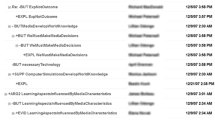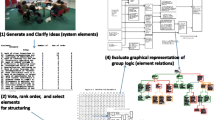Abstract
This study examined the effects of conversational language (e.g., asking questions, inviting replies, acknowledgments, referencing others by name, closing signatures, ‘I agree, but’, greetings, etc.) on the frequency and types of responses posted in reply to given types of messages (e.g., argument, evidence, critique, explanation), and how the resulting response patterns support and inhibit collaborative argumentation in asynchronous online discussions. Using event sequence analysis to analyze message-response exchanges in eight online group debates, this study found that (a) arguments elicited 41% more challenges when presented with more conversational language (effect size .32), (b) challenges with more conversational language elicited three to eight times more explanations (effect size .12 to .31), and (c) the number of supporting evidence elicited by challenges was not significantly different from challenges that used more versus less conversational language. Overall, these and other findings from exploratory post-hoc tests show that conversational language can help to produce patterns of interaction that foster high levels of critical discourse, and that some forms of conversational language are more effective in eliciting responses than others.
Similar content being viewed by others
References
R. Bakeman J. Brownlee (1982) Social rules governing object conflicts in toddlers and preschoolers K.H. Rubin H.S. Ross (Eds) Peer relationships and social skills in childhood Springer-Verlag New York 99–111
R. Bakeman J. Gottman (1997) Observing interaction: An introduction to sequential analysis University Press Cambridge
M. Baker (1999) Argumentation and constructive interaction P. Courier J.E.B. Andriessen (Eds) Foundations of argumentative text processing Amsterdam University Press Amsterdam 179–202
M. Baker K. Lund (1997) ArticleTitlePromoting reflective interactions in a CSCL environment Journal of Computer Assisted Learning 13 175–193 Occurrence Handle10.1046/j.1365-2729.1997.00019.x
Bakhtin, M. (1981). Dialogic imagination. Michael Holquist, (ed.), (Trans. Caryl Emerson and Michael Holquist). Austin: University of Texas Press
Beers, P.J., Boshuizen, E. & Kirschner P. (2004). Computer Support for knowledge construction in collaborative learning environments. Paper presented at the American Educational Research Association Conference, San Diego, CA
R.L. Birdwhistell (1955) ArticleTitleBackground to kinesics Et cetera 13 10–18
E. Burge (2000) ArticleTitleUsing learning technologies: Ideas for keeping one’s balance Open Praxis 1 17–20
J.K. Burgoon R. Knoper (1984) ArticleTitleNonverbal and relational communication associated with reticence Human Communication Research 10 601–626 Occurrence Handle10.1111/j.1468-2958.1984.tb00034.x
Cho, K. & Jonassen, D. (2002). The effects of argumentation scaffolds on argumentation and problem solving. Educational Technology Research and Development, 50(3): 5–22. Retrieved March 3, 2004 from http://tiger.coe.missouri.edu/~jonassen/Argumentation.pdf
R.E. Clark (1983) ArticleTitleReconsidering research on learning from media Review of Educational Research 43 IssueID4 445–459 Occurrence Handle10.2307/1170217
T.M. Duffy B. Dueber C.L. Hawley (1998) Critical thinking in a distributed environment: A pedagogical base for the design of conferencing systems C.J. Bonk K.S. King (Eds) Electronic collaborators: Learner-centered technologies for literacy, apprenticeship, and discourse Erlbaum Mahwah, NJ 51–78
S. Duncan D.W. Fiske (1977) Face-to-face interaction Lawrence Erlbaum Hillsdale, NJ
P. Fahy (2002a) ArticleTitleEpistolary and expository interaction patterns in a computer conference transcript Journal of Distance Education 17 IssueID1 20–35
P. Fahy (2002b) ArticleTitleUse of linguistic qualifiers and intensifiers in computer conference The American Journal of Distance Education 16 IssueID1 5–22 Occurrence Handle10.1207/S15389286AJDE1601_2
Fahy, P. (2003). Indicators of support in online interaction. International Review of Research in Open and Distance Learning, 4(1). Retrieved April 21, 2004 from: http://www.irrodl.org/content/v4.1/fahy.html
A. Feenburg (1989) The written world: On the theory and practice of computer conferencing R. Mason A. Kaye (Eds) Mindweave Pergamon Press Toronto 22–39
R. Garrison (2000) ArticleTitleTheoretical challenges for distance education in the 21st century: A shift from structural to transactional issues International Review of Research in Open and Distance Learning 1 IssueID1 1–17
J.M. Gottman (1979) Marital interaction: Experimental investigations Academic Press New York
C. Gunawardena C. Lowe T. Anderson (1997) ArticleTitleAnalysis of global on-line debate and the development of an interaction analysis model for examining social construction of knowledge in computer conferencing Journal of Educational Computing Research 17 397–431
Herring, S. (1993). Gender and democracy in computer-mediated communication. Electronic Journal of Communication, 3(2). Retrieved August 22, 2001 from http://www.cios.org/www/ejc/v3n293.htm
S. Herring (1996) Two variants of an electronic message schema S. Herring (Eds) Computer-mediated communication: Linguistic, social and cross-cultural perspectives John Benjamins Amsterdam 81–106
A. Jeong (2003) ArticleTitleThe sequential analysis of group interaction and critical thinking in on-line threaded discussions The American Journal of Distance Education 17 IssueID1 25–43 Occurrence Handle10.1207/S15389286AJDE1701_3
Jeong, A. & Juong, S. (in press). The effects of response constraints and message labels on group interaction and argumentation in online discussions. Computers and Education
Jeong, A. (in press). The effects of gender interaction patterns on student participation in computer-supported collaborative argumentation. Educational Technology, Research, and Development 54(4)
Jeong, A. (2005a). The effects of linguistic qualifiers on group interaction patterns in computer-supported collaborative argumentation. International Review of Research in Open and Distance Learning, 6(3). Retrieved November 1, 2005 from http://www.irrodl.org/content/v6.3/jeong.html
A. Jeong (2005b) ArticleTitleA guide to analyzing message-response sequences and group interaction patterns in computer-mediated communication Distance Education 26 IssueID3 367–383 Occurrence Handle10.1080/01587910500291470
Jeong, A. (2005c). Discussion analysis tool. Retrieved May 10, 2005, from http://garnet.fsu.edu/~ajeong/DAT
D. Johnson R. Johnson (1992) Creative controversy: Intellectual challenge in the classroom Interaction Book company Edina, Minn
Jonassen, D. & Remidez, H. (2002). Mapping alternative discourse structures onto computer conference. Paper presented at the Paper presented at Computer Support for Collaborative Learning 2002 Conference: Foundations for a CSCL Community, Boulder, CO
D.H. Jonassen H.I. Kwon (2001) ArticleTitleCommunications patterns in computer mediated versus face-to-face group problem solving Educational Technology Research & Development 49 IssueID1 35–51
W.J. Jordan W.G. Powers (1978) ArticleTitleVerbal behavior as a function of apprehension and social context Human Communication Research 4 294–300 Occurrence Handle10.1111/j.1468-2958.1978.tb00715.x
Karacapilidis, N. & Papadias, D. (2001). Computer supported argumentation and collaborative decision making: The Hermes system. In proceedings of the computer support for collaborative learning (CSCL) 2001 conference
D.A. Keast (1997) ArticleTitleToward an effective model for implementing distance education programs American Journal of Distance Education 11 IssueID2 39–55 Occurrence Handle10.1080/08923649709526960
C.E. Kimble S.D. Seidel (1991) ArticleTitleVocal signs of confidence Journal of Nonverbal Behavior 15 99–106 Occurrence Handle10.1007/BF00998265
M.L. Knapp J.A. Hall (1992) Nonverbal communication in human interaction EditionNumber3 Holt, Rinehart & Winston Ft. Worth, TX
T. Koschmann (1996) Paradigm shifts and instructional technology T. Koschmann (Eds) CSCL: Theory and practice of an emerging paradigm Lawrence Erlbaum Mahwah, NJ 1–23
R.B. Kozma (1994) ArticleTitleWill media influence learning? Reframing the debate Educational Technology Research and Development 42 IssueID2 7–19 Occurrence Handle10.1007/BF02299087
Leinonen, T., Virtanen, O. & Hakkarainen, K. (2002). Collaborative discovering of key ideas in knowledge building. In Proceedings of the computer support for collaborative learning 2002 conference. Boulder, CO. Retrieved May 19, 2004 from: http://fle3.uiah.fi
D. Lemus D. Seibold A. Flanagin M. Metzger (2004) ArticleTitleArgument and decision making in computer-mediated groups Journal of Communication 54 IssueID2 302–320 Occurrence Handle10.1093/joc/54.2.302
Levin, J., Kim, H. & Riel, M. (1990). Analyzing instructional interactions on electronic message networks, Online Education, L. Harasim (ed.), pp. 185–213, New York: Praeger
McAlister, S. (2003). Assessing good argumentation. Retrieved April, 10, 2004, from http://iet.open.ac.uk/pp/s.r.mcalister/personal/AssessingGEA.htm
A. Mehrabian (1968) ArticleTitleCommunication without words Psychology Today 2 IssueID9 52–55
D. Newman C. Johnson C. Cochrane B. Webb (1996) ArticleTitleAn experiment in group learning technology: Evaluating critical thinking in face-to-face and computer supported seminars Interpersonal Computing and Technology: An Electronic Journal for the 21st Century 4 IssueID1 57–74
G. Olson J. Herbsleb H. Rueter (1994) ArticleTitleCharacterizing the sequential structure of interactive behaviors through statistical and grammatical techniques Human-Computer Interaction 9 IssueID3/4 427–472
M.S. Poole M.E. Holmes (1995) ArticleTitleDecision development in computer-assisted group decision making Human Communication Research 22 IssueID1 90–127 Occurrence Handle10.1111/j.1468-2958.1995.tb00363.x
L. Rourke T. Anderson D.R. Garrison W. Archer (2001) ArticleTitleMethodological issues in the content analysis of computer conference transcripts International Journal of Artificial Intelligence in Education 12 8–22
V. Savicki M. Kelley B. Ammon (2002) ArticleTitleEffects of training on computer-mediated communication in single or mixed gender small task groups Computers in Human Behavior 18 257–269 Occurrence Handle10.1016/S0747-5632(01)00048-6
M. Scardamalia C. Bereiter (1996) Computer support for knowledge-building communities T. Koschman (Eds) CSCL: Theory and practice of an emerging paradigm Erlbaum Mahwah NJ 249–268
A.W. Siegman (1978) The telltale voice: Nonverbal messages of verbal communication A.W. Siegman S. Feldstein (Eds) Nonverbal behavior and communication Lawrence Erlbaum Hillsdale, NJ 183–243
Sloffer, S., Dueber, B. & Duffy, T. (1999). Using asynchronous conferencing to promote critical thinking: Two implementations in higher education. Retrieved October 30, 2003, from http://crlt.indiana.edu/publications/crlt99–8.pdf
Stegmann, K., Weinberger, A., Fischer, F. & Mandl, H. (2004). Can computer-supported cooperation scripts facilitate argumentative knowledge construction? Paper presented at the American Educational Research Association Conference, San Diego, CA. Retrieved May 24, 2004, from http://home.emp.paed.uni-muenchen.de/~weinberg/download
D.N. Stern (1974) Mother and infant at play: The dyadic interaction involving facial, vocal, and gaze behaviors M. Lewis L.A. Rosenblum (Eds) The effect of the infant on its caregiver Wiley New York 187–213
S.E. Toulmin (1958) The uses of argument University Press Cambridge
A. Kleeck ParticleVan R.L. Street SuffixJr. (1982) ArticleTitleDoes reticence mean just talking less? Qualitative differences in the language of talkative and reticent preschoolers Journal of Psycholinguistic Research 11 609–629 Occurrence Handle10.1007/BF01067615
J. Walther (1992) ArticleTitleInterpersonal effects in computer-mediated interaction Communication Research 19 IssueID1 52–90
A. Weinberger B. Ertl F. Fischer H. Mandl (2005) ArticleTitleEpistemic and social scripts in computer-supported collaborative learning Instructional Science 33 1–30 Occurrence Handle10.1007/s11251-004-2322-4
J. Wiley J. Voss (1999) ArticleTitleConstructing arguments from multiple sources: Tasks that promote understanding and not just memory for text Journal of Educational Psychology 91 301–311 Occurrence Handle10.1037/0022-0663.91.2.301
Winn, W. (1990). Media and instructional methods. In R. Ganisan, and D. Shue, (eds), Education at a Distance. Malabu, FL: Krieger
Author information
Authors and Affiliations
Corresponding author
Rights and permissions
About this article
Cite this article
Jeong, A.C. The Effects of Conversational Language on Group Interaction and Group Performance in Computer-Supported Collaborative Argumentation. Instr Sci 34, 367–397 (2006). https://doi.org/10.1007/s11251-006-0002-2
Received:
Accepted:
Issue Date:
DOI: https://doi.org/10.1007/s11251-006-0002-2




